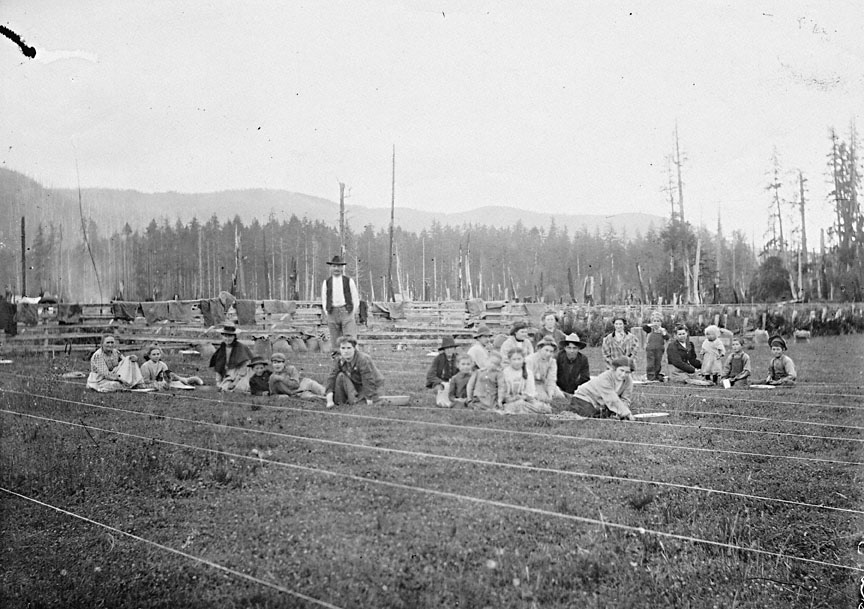- Catalog No. —
- OHS SIF 1050-A
- Date —
- 1912
- Era —
- 1881-1920 (Industrialization and Progressive Reform)
- Themes —
- Agriculture and Ranching, Environment and Natural Resources, Labor, Trade, Business, Industry, and the Economy
- Credits —
- Oregon Historical Society
- Regions —
- Coast
- Author —
- Unknown
Picking Cranberries at Sandlake
This photograph shows workers, primarily women and children, harvesting cranberries near Sandlake in Tillamook County. It was taken around 1912.
Massachusetts-native Charles D. McFarlin is generally credited with developing Oregon’s first commercial cranberry bog. In May 1885 he moved to Coos County, where he planted a cranberry bog using vines from a variety that he had developed in Massachusetts from wild vines. This variety, called the McFarlin, has larger berries than the native Oregon bog cranberry. McFarlin actually considered his variety to be ill-suited for Oregon since it did not ripen until October. “As a result,” he wrote in a 1900 letter, “when I send my berries to the San Francisco market I find myself in competition with the Eastern product.” He preferred earlier ripening varieties like the Black Veil and the Black Diamond.
Unlike McFarlin, Sandlake’s W.C. King considered the McFarlin variety an excellent choice for Oregon’s growing conditions. He claimed to produce 1,000 bushels per acre, several times more than the average yield at that time. King started growing cranberries in 1893 and by the turn of the century he was considered the “cranberry king” of Tillamook County. He wrote to the Oregonian in 1900 that the “picking season is usually one of pleasure to picker and grower. The weather generally is fine—September and October—and men, women and children come for an outing in the cranberry fields. They come with a camping outfit prepared to enjoy the pleasure of outdoor life. Lines are stretched three feet apart across a plot of ground, and the pickers work between the lines.” These lines can be seen in the photograph reproduced above. He noted that pickers earned 50 cents per bushel. “My best pickers,” King wrote, “average about three bushels a day.”
By 1924 the Oregonian reported that 100 acres of cranberry bogs were under cultivation in Clatsop County and another 40 acres in Coos County. Oregon’s cranberry industry contracted during the Depression of the 1930s, however. In a 1941 study, geographer Albert Seeman reported that there were only about seventy-five acres of cranberry bogs left in Oregon.
Cranberry production remained limited in Oregon until 1946, when the national cranberry cooperative Ocean Spray extended membership to Oregon growers. Today Oregon is the fourth largest producer of cranberries in the United States behind Wisconsin, Massachusetts, and New Jersey. Most of Oregon’s cranberries are produced in the Bandon area, where the McFarlin is still a popular variety.
Further Reading:
Seeman, Albert L. “Cranberry Industry of the Pacific Coast,” Economic Geography 17, 1941: 180-186.
Written by Cain Allen, Oregon Historical Society, 2006.
